Westminster Abbey
In some ways the most Newtonian place: Newton is laying there even as you read this.
Westminster Abbey has a special place within the structure of the Church of England. It is neither a parish church nor the seat of a bishop, and it does not fall under the jurisdiction of the Archbishop of Canterbury. The Abbey is administered by the Dean and Chapter who are directly responsible to the crown. As the location of national events such as coronations, the Abbey acquired the status of a ``National Church'' and from the seventeenth century onwards became the resting place of many national figures. It is for this reason that Newton was buried there when he died at his house in Kensington in 1727.
 Newton lay in state in the Jerusalem Chamber before the funeral on the
4th April 1727.
The pall bearers were the Lord Chancellor, the dukes of Montrose and
Roxburgh, the earls of Pembroke, Sussex, and Macclesfield, and the service
was performed by the Bishop of Rochester. Voltaire was among the other
mourners.
Newton lay in state in the Jerusalem Chamber before the funeral on the
4th April 1727.
The pall bearers were the Lord Chancellor, the dukes of Montrose and
Roxburgh, the earls of Pembroke, Sussex, and Macclesfield, and the service
was performed by the Bishop of Rochester. Voltaire was among the other
mourners.
Newton's is buried in the Nave, outside the screens which mark the area for which an admission charge is made (since it contains most of the other interesting individuals, including Poets' Corner.) Entering through the West Door next to the Gift Shop (in deep shade on the photograph) pass to the left of the grave of the Unknown Warrior and along the North Aisle as far as the Altar in front of the screens separating the Nave from the Choir. There is an elaborate memorial to Newton on the north screen (to the left of the Altar.) This was executed by W. Kent and J.M. Rysbrack in 1731 and contains symbolic references to Newton's work.
The grave itself is several feet in front of this and is surrounded by memorials and graves of many other mathematicians and physicists: William Herschel (1738-1822), and his son John Frederick William Herschel (1792-1871), Michael Faraday (1791-1867), George Greeen (1793-1841), William Thomson (Lord Kelvin, 1824-1907), James Clerk Maxwell (1831-1879), J.J. Thomson (1856-1940), Ernest Rutherford (1871-1937).
Sometimes during services, the stone marking Newton's grave is obscured by the Abbey authorities: they place a cupboard on wheels over the mortal remains of England's greatest scientist.
Westminster Abbey has a page about Newton and his monument.
© 1994-1999 Andrew McNab. Back to newton.org.uk